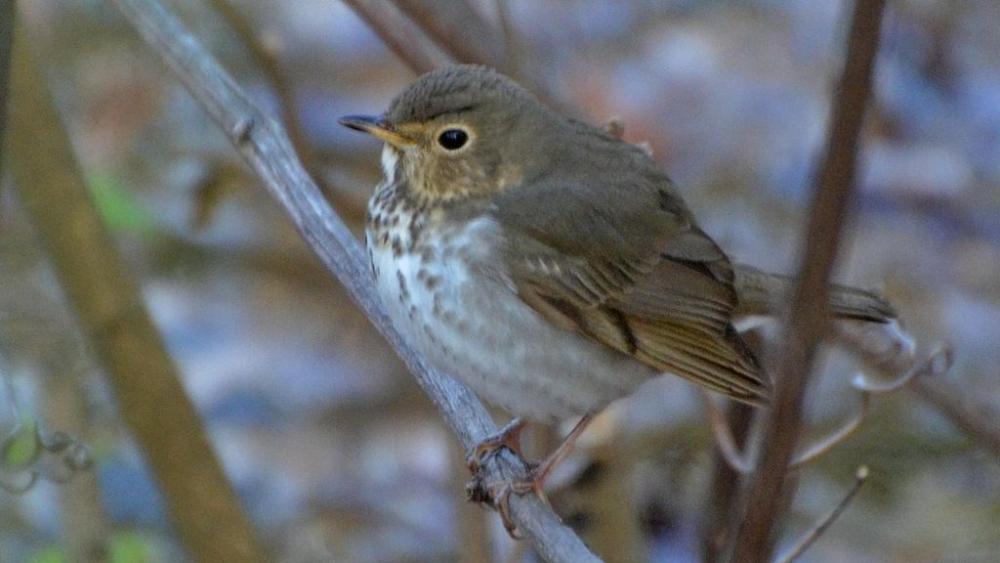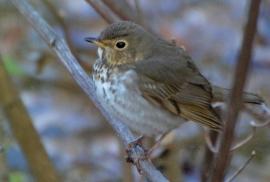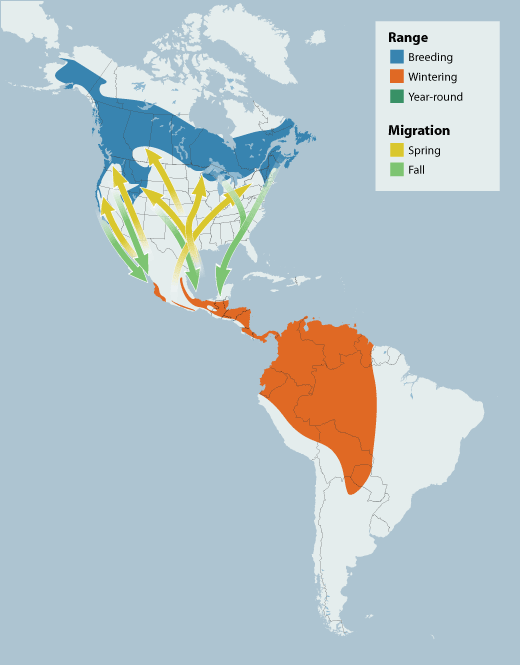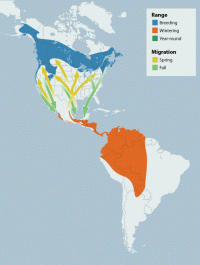Guide to Boreal Birds
This is an in-depth boreal species profile.
What is this?
This species is one of more than 30 birds selected for in-depth profiles. Find out why and see all selected boreal birds »
Overview
This bird is named after the English naturalist William Swainson (1789-1855). Like the Hermit Thrush, it is a furtive, ground-dwelling bird of the northern forests. Heard more often than seen, the shy Swainson's Thrush is one of our most beloved songsters. Across its boreal and western breeding range, its ethereal, flutelike song is one of the most prominent natural sounds. Its song, while perhaps not as beautiful as that of the Hermit Thrush, is better known to most bird-watchers because the species sings more frequently during migration. Because each bird's territory is small and the species is abundant, one may hear a chorus of male Swainson's Thrushes sing briefly every morning and evening. This species sings, feeds, and breeds in shady thickets; migrants fly at night, feeding and resting during the day. Swainson's Thrush occurs in two subspecies groups, the "Russet-backed Thrush" of the western boreal region and Pacific coast and the "Olive-backed Thrush" of the eastern boreal region, Rockies, and Appalachians. These forms differ in plumage, breeding habitat, winter range, and certain vocalizations. Population declines and even disappearances cloud the future of this melodious species.
Description
6 1/2 -7 3/4" (17-20 cm). Uniformly dull olive-brown or olive-russet above, spotted below, with buff eye ring and cheek. The Gray-cheeked Thrush is similar, but has grayish cheeks and lacks conspicuous eye ring.
Voice
Song a series of reedy spiraling notes inflected upward.
Nesting
3 or 4 pale green-blue eggs, finely spotted with light brown, in a well-built cup of moss and lichen lined and strengthened with twigs, leaves, and grass. The nest is generally concealed in a small forest shrub or tree.
Habitat
Swainson's Thrush is a bird of dense, coniferous (especially fir, spruce, and hemlock) forests across most of its range; in California and the southern Rockies, however, it occurs in deciduous (willow, alder, and aspen) riparian woodland and shrubby, wet, meadows. In the Northeast, it also occurs, though at lower densities, in hardwood forests with several other closely related thrush species. In most areas, it avoids competition with these species by utilizing different elevations, foraging strategies, or habitat. As is typical of most species, it is less particular about habitat during migration, dense undergrowth being the main requirement. It winters in primary and, to a lesser extent, secondary forests and edges of many types.
Range/Migration
Fall migration of eastern populations is mostly along the Atlantic coast (peaking in August in the Maritimes and October in Florida) and across the Gulf of Mexico to Central America, then south to South America. The winter range of these populations extends from northernmost South America south through the western Amazon Basin to northern Argentina. They depart these areas in March, moving north along the east side of Central America and up the west side of the Gulf of Mexico in April and May, then fanning out across the Mississippi Valley, arriving on the breeding grounds in May and June. Western populations migrate both north and south along the Pacific coast and winter in tropical Mexico and Central America.
Breeding
Swainson's Thrush breeds throughout the North American boreal region as well as along the Pacific coast nearly to Mexico and in the Cascades, northern Sierra Nevada, Rocky Mountains, and northern Appalachians. Almost 60 percent of the global population of Swainson's Thrush breeds in the boreal forest of North America. Swainson's Thrush, like most North American songbirds, is seasonally monogamous. However, since females show an unusually high degree of between-year fidelity to their nest sites, pairs often re-form in multiple seasons after repeating the pair-bonding process. This may facilitate rapid pairing, important in high-altitude, northern regions where the breeding season is short. Males, which arrive on the breeding grounds first, initially try to drive arriving females off their territories. After several days of female persistence, which may be strengthened by the male's defensive behavior, the male accepts the female and mating occurs. The nest is built by the female and typically placed in dense understory cover. One to five (usually four) speckled, blue eggs are laid and incubated for 10 to 14 days. The young fledge at 10 to 14 days as well, after being fed by both parents. Nest failure rates in this species are very high, sometimes exceeding 60 percent; it is believed that most females never nest successfully.
Diet/Feeding Behavior
Like other thrushes, Swainson's Thrush is omnivorous, eating mostly insects during spring and summer and fruits in fall and winter. Beetles, caterpillars, and ants are among the principal insect prey; few temperate songbirds exploit ants to the extent that this and related species do. Typical fruits eaten include blue-, crow-, elder-, black-, rasp-, twin-, and huckleberries. It usually forages on or near the ground but spends more time foraging above ground than similar thrushes, sometimes even in the canopy. Its relatively short feet and long wings may be adaptations for arboreal foraging. It uses a variety of foraging techniques, especially pecking and gleaning (typical of thrushes) but also aerial-lunging, hovering, and fly-catching. In the tropics, it follows army-ant swarms like many resident tropical species, which typically displace it when encounters occur.
References
Cherry, J.D. 1985. Early autumn movements and prebasic molt of Swainson's Thrushes. Wilson Bull. 97:368-370.
Dilger, W.C. 1956. Adaptive modifications and ecological isolating mechanisms in the thrush genera Catharus and Hylocichla. Wilson Bull. 68:171-199.
Dilger, W.C. 1956. Hostile behavior and reproductive isolating mechanisms in the avian genera Catharus and Hylocichla. Auk 73:313-353.
Evans Mack, D., and W. Yong. 2000. Swainson's Thrush (Catharus ustulatus). In The Birds of North America, No. 540 (A. Poole and F. Gill, Eds.). Philadelphia: The Academy of Natural Sciences; Washington, D.C.: The American Ornithologists' Union.
Johnson, M.D., and G. R. Geupel. 1996. The importance of productivity to the dynamics of a Swainson's Thrush population. Condor 98:133-141.
Noon, B.R. 1981. The distribution of an avian guild along a temperate elevational gradient: the importance and expression of competition. Ecol. Monogr. 51:105-124.
Sauer, J. R., J. E. Hines, and J. Fallon. 2003. The North American Breeding Bird Survey, Results and Analysis 1966-2002, Version 2003.1, USGS Patuxent Wildlife Research Center, Laurel, MD.
Winker, K., D.W. Warner, and A.R. Weisbrod. 1992. The Northern Waterthrush and Swainson's Thrush as transients at a temperate inland stopover site. Pp. 384-402 in Ecology and conservation of neotropical migrant landbirds (J.M. Hagan, III, and D.W. Johnston, eds.). Smithson. Inst. Press, Washington, D.C.
Credits
Birding content provided by National Wildlife Federation/eNature, with support from Ducks Unlimited/The Pew Charitable Trusts.





